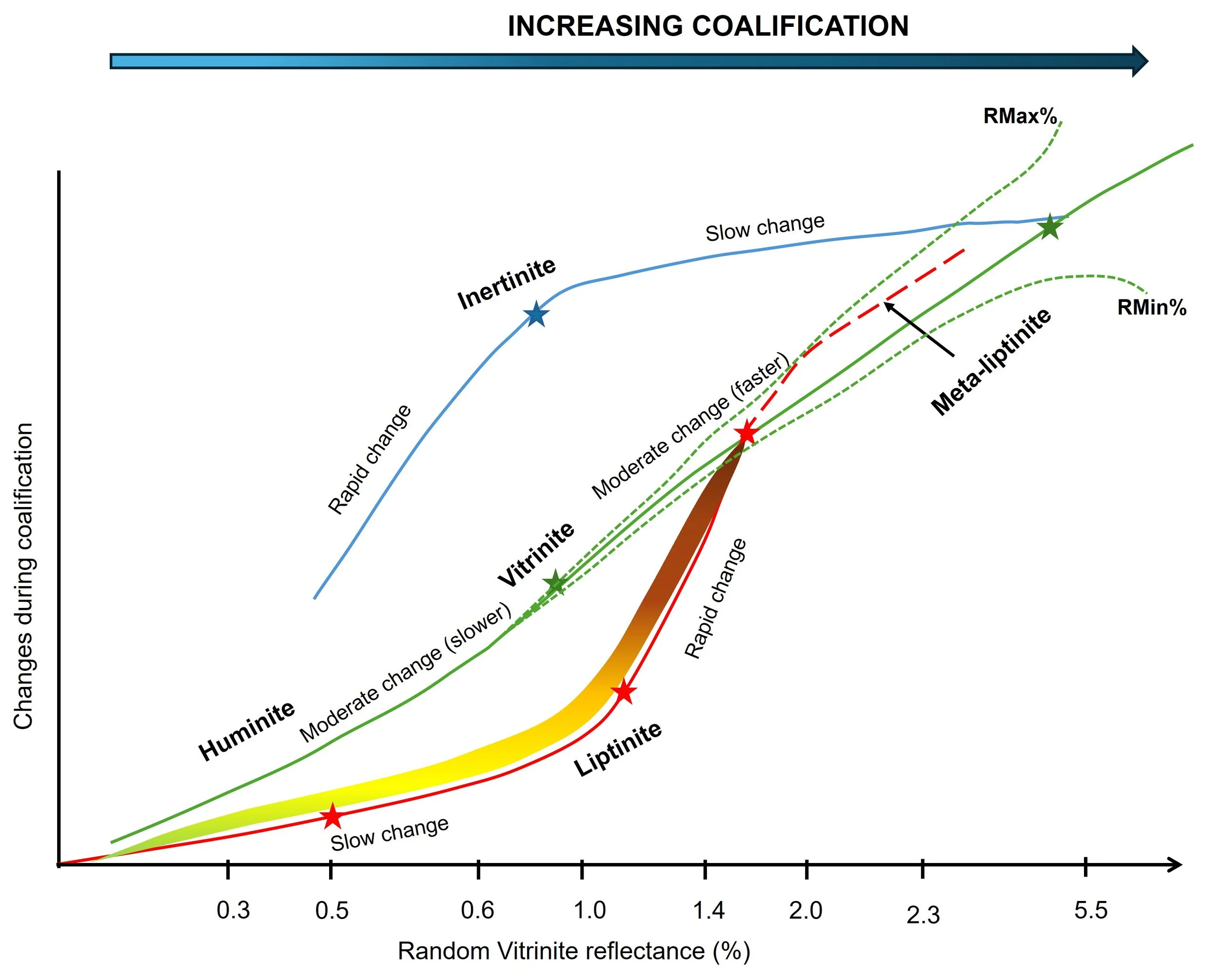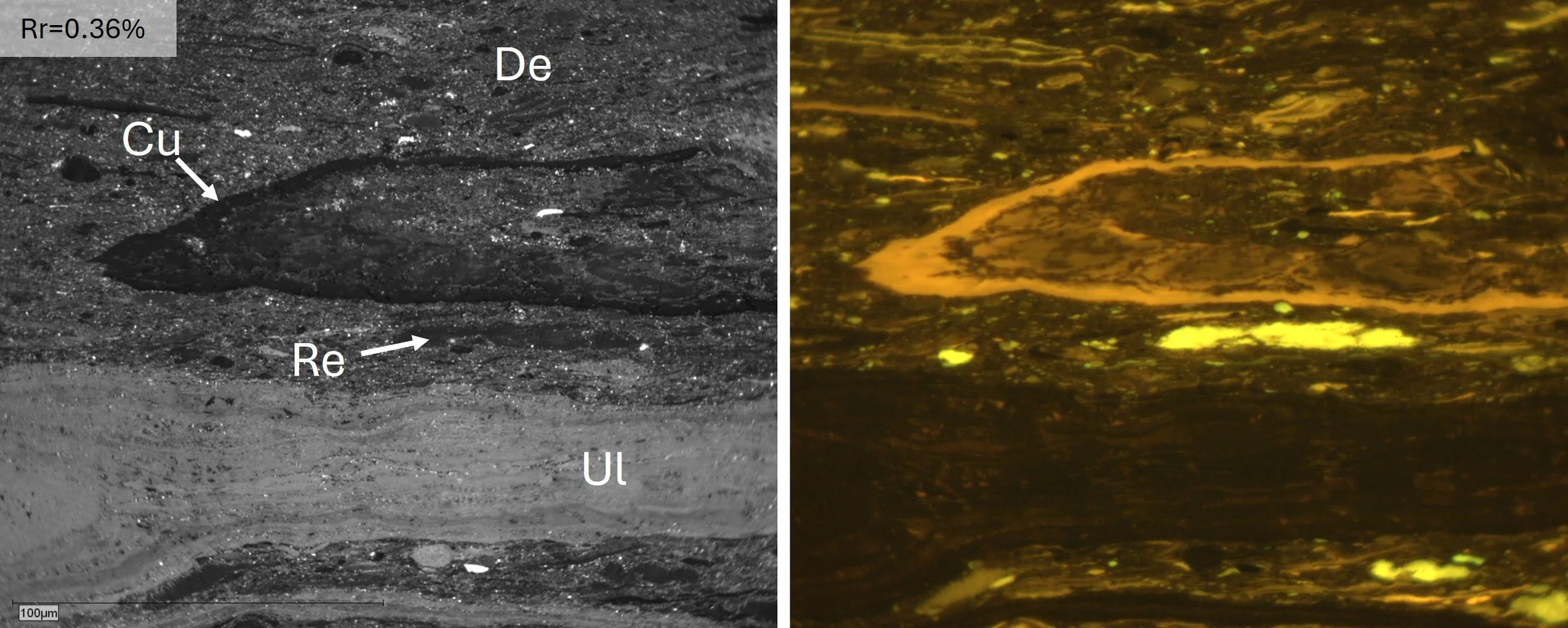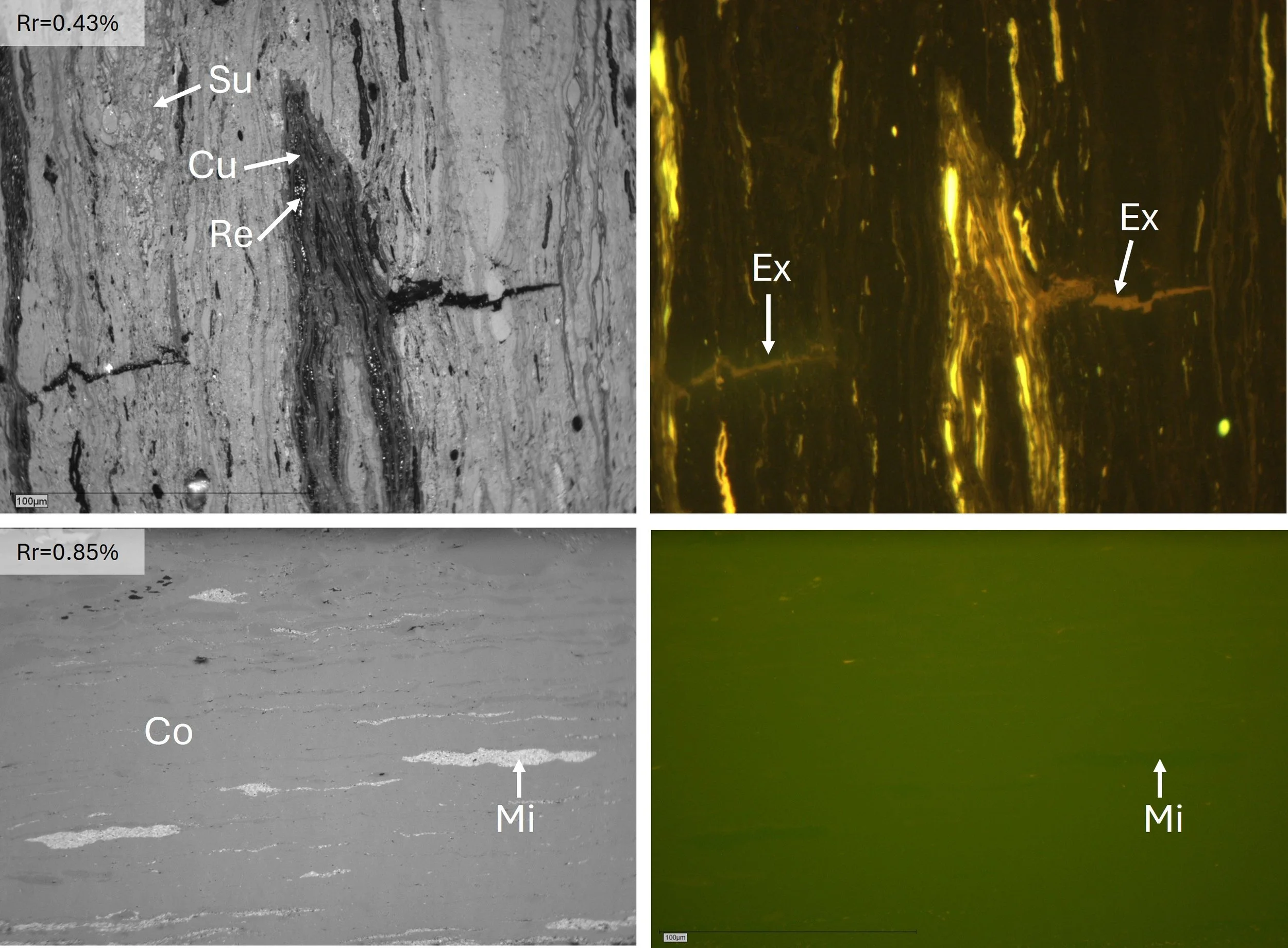Good to Know Series – 06 – Petrographic Changes During Coalification
In previous episodes, we talked about the coalification process, macerals, and rank. These are important concepts to understand when looking at the petrographic changes of macerals during coalification.
What really excites me about petrography is that you can attach an image to a value obtained by chemical or physical methods — and today, we'll look at some examples of that.
What petrographic features can we observe under the microscope?
Increase in reflectance
Homogenisation of huminite/vitrinite macerals
Formation of secondary macerals (exsudatinite and micrinite)
“Disappearance” of liptinite macerals
Development of reflectance anisotropy
Loss of fluorescence
Let’s explore these in more detail. As shown in the figure below, coal maceral groups follow different paths during the coalification process. Vitrinite shows the most consistent progression. However, the rate of reflectance increase is slower below 1% Rr and becomes faster after that — especially at the anthracite stage.
This reflects an initial homogenisation of huminite, followed by increasing aromatisation of vitrinite. Aromatisation, combined with increased lithostatic pressure, leads to the development of reflectance anisotropy (or bireflectance — the difference between RMax% and RMin%), due to the orientation of aromatic nuclei (or basic structural units, BSUs) within the bedding plane.
At lower ranks, vitrinite can exhibit weak fluorescence, especially when compared to liptinite macerals. According to Taylor et al. (1998), vitrinite fluorescence decreases down to 0.5% Rr, increases again up to 1.1% Rr, and disappears around 1.3% Rr. This secondary fluorescence has been linked to oil generation during bituminisation.
Petrographic changes during coalification (modified from Smith and Cook (1980). Image not at scale.
Liptinite reflectance begins low, but increases rapidly after ~1.2% Rr, approaching that of vitrinite around 1.4–1.6% Rr. At this stage, liptinite can be difficult to distinguish from associated vitrinite. However, with further coalification, liptinite reflectance can exceed that of vitrinite, making it distinguishable once again. These altered liptinites are called meta-liptinites. They often show higher anisotropy than the associated vitrinite and are therefore easier to identify using a polariser. Unfortunately, meta-liptinites are often overlooked in maceral studies and grouped with inertinite due to their optical similarity.
The main optical characteristic of liptinite macerals is their fluorescence under UV or blue light. In low-rank coals, liptinites fluoresce strongly in green or yellow. As rank increases, fluorescence shifts toward orange and brown, coinciding with the oil generation window, and disappears completely around 1.4% Rr — approximately marking the end of the oil window.
It’s important to note that the figure above shows a general trend for the liptinite group. Individual macerals begin generating oil at different times, so their optical properties change at different rates. According to Khorasani and Murchison (1988), based on fluorescence spectrum observations, suberinite is the first to generate oil, followed by terpene resinite, cutinite, sporinite, alginite, and lipid resinite. The secondary maceral exsudatinite can form from these at different times during oil generation. After oil generation, some of these liptinites may leave behind a solid residue known as micrinite.
Many inertinite macerals already have high reflectance early on, as they are essentially “pre-coalified” due to the palaeoenvironmental conditions during deposition. As a result, their changes through coalification aren’t as marked as those of liptinites and vitrinites. However, low-reflectance semifusinites and other inertinites can show a rapid reflectance increase up to the high-volatile bituminous stage. Some may exhibit very weak fluorescence at this point. These types of inertinites do not behave like true inerts during carbonisation. At higher ranks, inertinite evolution slows significantly.
Coal sample from Eromanga Basin. Photomicrographs taken with oil immersion objectives in white (left) and fluorescent light (right) Legend: De – densinite; Ul – ulminite; Cu – cutinite; Re – resinite.
Features to notice:
• Heterogeneity of the Huminite group (ulminite and densinite).
• Huminite group possess fluorescence but much weaker than that of the liptinite group macerals (resinite and cutinite).
• Liptinite macerals present different fluorescence intensities.
Coal samples from the Surat Basin (0.43% Rr) and one coal sample from the Bowen Basin (0.85% Rr). Photomicrographs taken with oil immersion objectives in white (left) and fluorescent light (right). Legend: Cu – cutinite; Re – resinite, Su – suberinite; Ex – exsudatinite; Co – collotelinite; Mi - micrinite.
Features to notice:
• Homogeneity of vitrinite (collotelinite) at higher rank.
• Formation of secondary macerals such as exsudatinite and micrinite.
• Exsudatinite has fluorescence and belongs to the liptinite group. Micrinite is non-fluorescent and belongs to the inertinite group.
• Liptinite macerals present different fluorescence intensities.
Coal samples from Bowen Basin. Photomicrographs taken with oil immersion objectives in white light. Legend: Co – collotelinite; Meta-Cu – meta-cutinite.
Features to notice:
• Higher reflectance of the liptinite (cutinite, now meta-cutinite) compared to the associated vitrinite (collotelinite).
• As the rank increases, the reflectance of the meta-liptinite becomes much higher than that of the vitrinite.
References
Peters, K.E., Cassa, M.R., 1994. Applied source rock geochemistry. AAPG Memoir 60. Chapter 5.
Smith, G.C., Cook, A.C., 1980. Coalification paths of exinite, vitrinite and inertite. Fuel 59, 641-646.
Taylor, G.H., Teichmuller, M., Davius, D., Diessel, C.F.K., Littke, R., Robert, P., 1998. Organic Petrology. Gebruder Borntraeger, Berlin, Stuttgart (704 pp).



